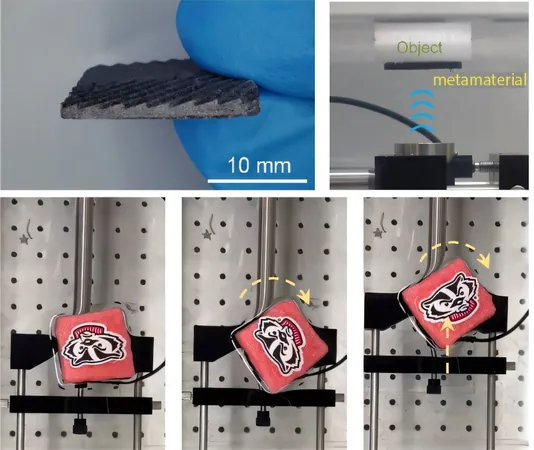
Revolutionary Metamaterial Uses Sound Waves to Move Underwater Objects Remotely!
2025-05-20
Author: Sarah
Imagine a world where sound waves can carry out intricate tasks beneath the surface of water! A groundbreaking metamaterial has recently been developed that allows us to manipulate objects underwater, all without physical contact.
At the forefront of this innovation is Dajun Zhang, a dedicated doctoral student from the University of Wisconsin-Madison. He is set to unveil his pioneering research at the 188th Meeting of the Acoustical Society of America, running from May 18 to 23.
What is This Amazing Metamaterial?
Metamaterials are fascinating composites that boast extraordinary properties due to their unique structures. Zhang's metamaterial features a specific sawtooth pattern on its surface, enabling adjacent speakers to exert varying forces. This clever design allows precise acoustic manipulation of objects—pushing and rotating them just by targeting sound waves!
Transforming Underwater Work—and Medicine!
The implications of this technology are vast. Not only could it simplify various underwater tasks, but it also holds promise for medical applications, particularly in performing remote surgeries or delivering drugs, given that the human body is predominantly made up of water.
Zhang marvels at the potential, stating, 'Our metamaterial can create distinct acoustic radiation forces in liquids, making it ideal for underwater robots, assembly parts, or even medical devices.'
Overcoming Manufacturing Challenges
However, there's a catch. Creating metamaterials suitable for underwater manipulation has been a challenging feat, mainly due to traditional fabrication methods that are expensive and lack the needed resolution.
To overcome these hurdles, Zhang has devised a novel fabrication method that is cost-effective, easier to implement, and crucially, achieves high resolution and a substantial acoustic impedance contrast with water.
Successful Tests and Future Aspirations
In his experiments, Zhang has successfully maneuvered various floating objects—like wood, wax, and even plastic foam—alongside fully submerged items. By attaching his metamaterial to these objects, he could use acoustic waves to adeptly control their movement in three dimensions.
Looking ahead, Zhang aims to refine his metamaterial into a smaller, more adaptable patch. His ultimate dream? To revolutionize underwater robotics and medical practices with this technology.
As Zhang eloquently puts it, 'Our research unlocks a treasure trove of possibilities for underwater acoustic metamaterials and remote manipulation, paving the way for innovative levitation and actuation applications.'
Stay tuned as we witness this fascinating intersection of sound and technology reshape the future!




 Brasil (PT)
Brasil (PT)
 Canada (EN)
Canada (EN)
 Chile (ES)
Chile (ES)
 Česko (CS)
Česko (CS)
 대한민국 (KO)
대한민국 (KO)
 España (ES)
España (ES)
 France (FR)
France (FR)
 Hong Kong (EN)
Hong Kong (EN)
 Italia (IT)
Italia (IT)
 日本 (JA)
日本 (JA)
 Magyarország (HU)
Magyarország (HU)
 Norge (NO)
Norge (NO)
 Polska (PL)
Polska (PL)
 Schweiz (DE)
Schweiz (DE)
 Singapore (EN)
Singapore (EN)
 Sverige (SV)
Sverige (SV)
 Suomi (FI)
Suomi (FI)
 Türkiye (TR)
Türkiye (TR)
 الإمارات العربية المتحدة (AR)
الإمارات العربية المتحدة (AR)